Great Times at Merit Badge U
By John H. Ostdick
Photographs By Dan Bryant
Alpha Phi Omega, the national service fraternity, hosts a day on the University of Texas campus in Austin for Boy Scouts and Venturers to work on merit badges and other outdoor skills.
- Alpha Phi Omega: Celebrating Nearly 80 Years of Service
- Much More Than Merit Badges
- Merit Badge University Facts
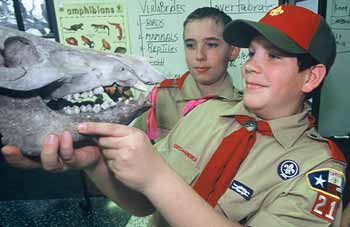 Joshua Davis of Troop 210, Schulenburg, Tex., examines a pig's skull while visiting a biology lab on the University of Texas campus. |
On a clear, breezy springlike day in February, Boy Scouts huddle around four professional surveyors and an orange survey tripod outside the Chemical Petroleum Engineering building on the University of Texas (U.T.) campus in Austin.
As a trim, bearded man ticks off marker readings, the Scouts scribble elevation figures and work the math of the trade. They line up a mark across the street, and, sure enough, they see the landmark U.T. Tower peeking above the campus buildings beyond.
The boys are among 1,300 Boy Scouts and Venturers attending the one-day Merit Badge University (MBU) on the U.T. campus. The annual event, hosted by Alpha Phi Omega (APO), the national service fraternity [see box on next page], brings together 200 volunteer instructors for a whirlwind day of exploration and learning.
In just four years, the young men and women from Alpha Rho, one of the nation's largest APO chapters, have turned a modest weekend merit badge fair into a mega learning opportunity that utilizes many of the U.T. campus resources.
"About four years ago we visited a merit badge event in San Antonio that had about 1,000 kids in attendance," explains Billy Russell, an Eagle Scout and Alpha Rho's service vice president. "We decided to hold a similar event in Austin, but we started at the district level and only had 47 Scouts the first year."
The following year, Alpha Rho opened the MBU to the entire Capitol Area Council, anticipating an attendance of just 200 Scouts. The surprising turnout of 600 was a bit overwhelming, Russell recalls.
In March 2003, the college students were better prepared for the 1,000 Scouts who swarmed the College of Engineering complex, site of the weekend program. The boost in attendance was helped by the addition of classes for new Boy Scouts and Venturers and leadership sessions for adults. In addition to the Austin area, attendees came from Houston and Corpus Christi to the south and Dallas-Fort Worth to the north.
Quality resources, instruction
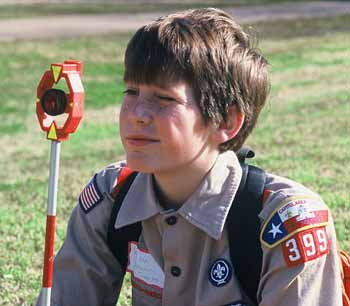 Wilson Bauer of Troop 399 sights a marker to measure elevations for the Surveying merit badge. |
"This is the largest and most successful event in the Capitol Area Council, and these Alpha Rho kids did it all," says attorney Jim Mallios, a unit commissioner in the council's Longhorn District, who is dressed as Benjamin Franklin to teach a Citizenship in the Nation merit badge class.
Scouter Tim Francis is well familiar with the MBU. As a university student he served as coordinator for the original event, and in 2003 he brought 11 Scouts from Troop 791 in the Sam Houston Area Council to Austin. "The resources here let the boys complete requirements for some merit badges they wouldn't find elsewhere," he says.
Scouter Barry Taylor, who heard about the MBU at a roundtable meeting, brought 16 Scouts, ages 11 to 17, from Troop 199 in Cedar Park, outside Austin.
"The boys can work on up to four merit badges in a day," he notes. "And my Scouts say they actually enjoy the classes, which speaks volumes about the quality of instruction."
The alliance with U.T. and its College of Engineering gives the Austin event a special appeal.
"A merit badge university like this not only provides Scouts the opportunity to earn the required badges for Eagle," notes John Van Overloop, 2004 MBU project coordinator, "but it also gives them the experience of visiting a college campus and interacting with faculty and community professionals."
From 8:30 a.m. to 5:30 p.m., the engineering complex hosts about 30 merit badge classes. Many begin in a classroom but then move outdoors or to other campus facilities.
For example, after a classroom briefing, the Architecture and Landscape Architecture classes relocated to the sun-strewn campus to study the university's buildings and grounds.
But merit badge study isn't the only advancement work available.
Venturers visit the campus archery range to work on the Shooting Sports elective for their Ranger Award, and younger Boy Scouts work on Tenderfoot rank requirements at task-oriented skill stations.
High-flying simulation
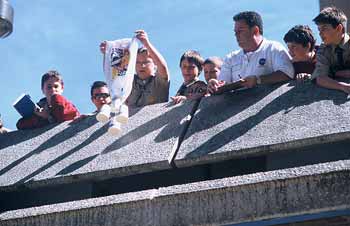 Scouts test their landing craft for the Space Exploration merit badge to see if an egg can survive a one-story drop. |
One of the most popular experiences is the university's Flight Link Advanced Simulation System, where Aviation merit badge instructors use flight simulators to provide Scouts with the sensation of actually flying an aircraft.
Clint Kam, a senior aerospace engineering student and MBU volunteer, walks each Scout through the simulation process.
Nearby, Tina Wang, another student volunteer, guides Second Class Scout Michael Newton of Austin Troop 457 through his initial "flight" inside a jet fighter simulator.
"Wait until this number gets to 1,700 and then you are going to push the wheel slowly forward, to inch along the runway for takeoff," Wang instructs.
Michael gains speed as he "taxis" down the imaginary runway on the screen in front of him. The simulator recreates all the jolting noises associated with a jet takeoff as Wang announces: "When you reach 150 knots, take off!"
"Oh, wow, I am taking off!" Michael exclaims.
"Altitude, altitude," an emotionless voice from the simulator intones. "You need to pull up," Wang urges gently.
"I am pulling up!" Newton protests. "Oh, yeah, woooo. Bring on a dogfight!"
Egg drop on a budget
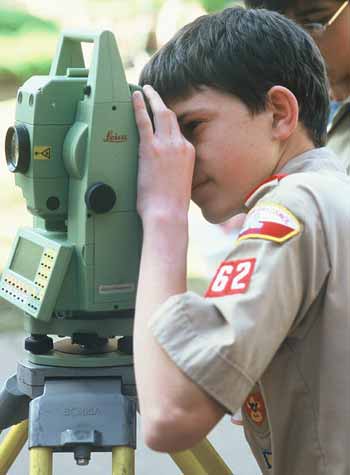 Life Scout Clark Fiedler of Troop 162 surveys distances between markers. |
High-tech gear is a special bonus, but the MBU relies heavily on the quality of its human resources, such as Joseph L. Williams Jr., who works for the National Aeronautics and Space Administration (NASA).
Williams, an APO alumnus who is in his third year of volunteering at MBU, leads the Space Exploration class through the process of budgeting, planning, and constructing a space landing craft that must protect a raw egg during a perilous one-story drop.
"First, sketch what your lander will look like, then build it from that sketch," Williams tells the class.
Each team gets a budget and picks items to buy from the lander construction supply sheet. Tracking expenses is important, Williams warns them. "You can build your lander any way you want, but you can't go over budget."
As the teams move outside to a courtyard landing, Second Class Scout Dylan Baddour of Austin Troop 146 says: "This is my favorite class. I like the fact that they actually got somebody from NASA to teach it."
He's skeptical about the success of his team's egg-protecting design, and his hunch is proved when the lander gets close to the mark but the egg breaks.
Second Class Scout Nicholas Barth of Georgetown Troop 155 is more optimistic. His lander soon reaches ground just south of the mark, egg intact. A few minutes later, Nicholas is all smiles: "Whoo-hoo, we won!"
As Scouts head off to lunch during the midday break, Joseph Williams notes that NASA Administrator Sean O'Keefe is a supporter of Scouting. He said the agency head wants to increase NASA's involvement with helping Boy Scouts earn the Space Exploration merit badge.
The final tally
Exploration and leadership prove buzzwords for the day.
"Learning and leadership, college and Scouting, U.T. and Merit Badge University—I hope you see the connections," Dr. Robert H. Bishop told the assembled participants. Dr. Bishop is professor and chairman of U.T.'s aerospace engineering and engineering mechanics departments.
"I meet many students, and I detect a noticeable difference in those who participate in Scouting and Venturing. And I take special note of Eagle Scouts. They are my leaders; it's just that simple."
Watching the Alpha Rho volunteers move in and out of the MBU's volunteer center, a lecture hall turned smorgasbord of merit badge college supplies, Bishop's observations are evident.
Amid piles of pencils, pens, pads, clipboards, crayons, paper clips, staplers, glue, batteries, rubber bands, calculators, and computers tracking the day's activities, volunteers move in and out of the room in a constant blur of motion. They are directing traffic, solving problems, and issuing instructions with two-way radios. Then it's time to set up dining tables for 1,400 people and coordinate pizza deliveries. Participants consume 360 pizzas and 1,600 soft drinks.
Afterward they clean up the area, break down the tables and chairs, and return them to storage.
At day's end, the Scouts have completed requirements for 1,016 merit badges and accumulate another 3,332 partials to be completed in their home units; 207 adults receive basic and advanced instruction; the U.T. band makes a thunderous appearance to honor the Scouts. Impressive totals for one day of fun and learning.
Freelance writer John H. Ostdick lives in Dallas, Tex.
Alpha Phi Omega: Celebrating Nearly 80 Years of Service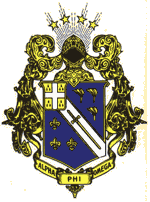
The national Alpha Phi Omega service fraternity was founded Dec. 16, 1925, at Lafayette College in Easton, Pa. Its leader, Frank Reed Horton, found in the Scout Oath and Law a "standard of manhood" that would withstand the test of time, and he hoped to create an organization for college men who would cooperate with all youth movements, especially Scouting. BSA registration was required for membership from 1925 through 1967. Since the 1970's, however, the service fraternity has evolved into a coed organization that, while not officially associated with the Boy Scouts of America, still adheres to Scouting principles. The organization's stated purpose is "to assemble college students in a national service fraternity in the fellowship of principles derived from the Scout Oath and Law of the Boy Scouts of America; to develop leadership, to promote friendship, and to provide service to humanity; and to further freedom that is our national, educational, and intellectual heritage." APO has 350 chapters nationwide, most of which do some service to Scouting. The Alpha Rho chapter at the University of Texas at Austin was the first at a university in the Lone Star State and the 40th in the nation. It's now one of the country's largest chapters, with members completing 10,000-plus hours of service per semester. "We're the second-largest organization on campus, behind the band," notes Billy Russell, chapter service vice president. He says the chapter works with four Cub Scout packs, helps with council fundraisers, and assists in activities for the council's annual Report to State event at the capitol. Members work at camporees; help clean up the LCRA Lost Pines Scout Reservation, the local council camp; and contact graduating Webelos Scouts to make sure they have a troop to join. "We put in about 5,000 hours for Scouting each year," Russell says. And in 2002, Alpha Rho was honored for its service to the BSA with the APO's M. R. Discorough Award. The Austin chapter provides service outside Scouting as well. Members work on an annual campus blood drive and on projects for the local Salvation Army, Boys & Girls Clubs, and Special Olympics. (For more about U.T.-Austin's Alpha Rho chapter, visit http://studentorgs.utexas.edu/apo/.) For additional information about APO, visit www.apo.org/ or call (816) 373-8667. — J.H.O. |
Much More Than Merit BadgesThe annual Merit Badge University in Austin has expanded to offer more than just merit badge classes. Additional programs include:
Venturing. Furry and about 50 other Venturers from the BSA's program for young adults ages 14 through 20 attended a range of special Venturing classes, such as backpacking, fly-fishing, fencing, chess, and archery, and sessions covering the Sea Scouting Bronze Award requirements. "We're trying to attract Venturers with subjects that aren't normally offered at typical merit badge universities—such as fencing and fly-fishing," explained William Thomas Mountz, MBU Venturing director. "We want to expand their knowledge, perhaps open new opportunities for them."
New Scouts. "We split the material into six program areas—first aid, camping, knots, plants and animals, compass, and the ax yard," says Tenderfoot director Charles Wilson, Comanche District commissioner. The Scouts spend a half-hour in the morning in each area and another half-hour in the afternoon, to reinforce the original sessions. They come together as a group for citizenship in the morning and water safety in the afternoon. Each Scout has a folder with a sheet listing the requirements for the three ranks, and the instructors highlight each Scout's completed tasks as the day goes on. At the end of the day, they can take their records back to their own unit.
Cub Scouts.
Adult Leaders. — J.H.O. |
Merit Badge University FactsAll proceeds from the U.T.-Austin Merit Badge University go to support programs of the Capitol Area Council. These include scholarships for Eagle Scouts attending the University of Texas, the purchase of Eagle Scout Award medals, support of the Order of the Arrow's commitment to LCRA Lost Pines Scout Reservation, and assistance with the Capitol Area Council's Friends of Scouting Campaign, the Hispanic Committee on Scouting, and Scoutreach initiative. The 2005 MBU is tentatively scheduled for Saturday, Feb. 19. For more information about MBU, visit www.utmbu.org. Other Alpha Phi Omega chapters host similar events. Some of the best attended include those at the University of Arkansas, University of Iowa, University of Massachusetts at Amherst, and the University of Colorado. For information, search the Web for "merit badge university" or "Scouting university" or contact your local Scout council service center. — J.H.O. |
September 2004 Table of Contents
Copyright © 2004 by the Boy Scouts of America. All rights thereunder reserved; anything appearing in Scouting magazine or on its Web site may not be reprinted either wholly or in part without written permission. Because of freedom given authors, opinions may not reflect official concurrence.